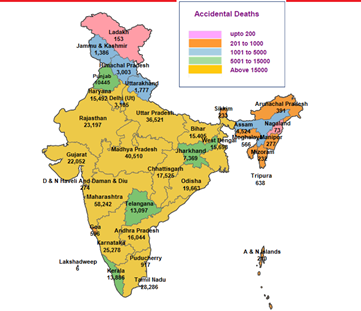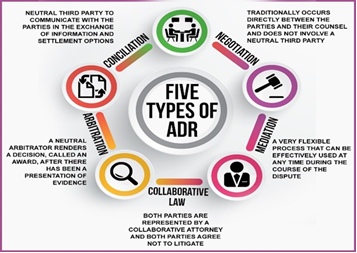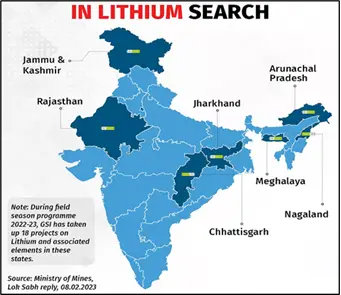Tuesday, 6th August 2024
How new tech promises to kill weeds in rice and wheat fields
Why in the news?
- Recently, breakthroughs have provided a silver lining in rice and wheat production as Agricultural scientists and policymakers involve breeding rice and wheat varieties/hybrids that tolerate the herbicide Imazethapyr, which controls competing weeds.
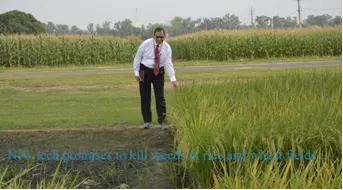
Recent Breakthroughs in Rice and Wheat Fields:
- Rice Fields
- In the current kharif season, two basmati rice varieties (Pusa Basmati 1979 and Pusa Basmati 1985) and two non-basmati rice hybrids (Sava 134 and Sava 127) have been commercially planted.
- These were developed by the Indian Agricultural Research Institute (IARI) and Savannah Seeds Pvt. Ltd.
- These contain a mutated acetolactate synthase (ALS) gene that enables farmers to spray Imazethapyr for controlling weeds in rice.
- Common weeds affecting rice cultivation are: Echinochloa colona (commonly called jangli chawal), Cyperus rotundus (motha), and Trianthema portulacastrum (patthar-chatta).
- Wheat Fields
- In the upcoming rabi season, Mahyco Pvt. Ltd plans to launch Imazethapyr-tolerant wheat varieties, Goal and Mukut.
- Imazethapyr is used for controlling Phalaris minor (gulli danda), Chenopodium album (bathua), and other such major weeds.
- Mahyco and Savannah Seeds have partnered to promote their 'FullPage' direct-seeded rice (DSR) and 'FreeHit' zero-tillage (ZT) wheat technologies, aiming to make farming more climate-smart and sustainable.
Prevailing Practices to Control Weeds:
- For Rice
- Farmers create nurseries to grow young plants, which are transplanted after 30 days into puddled fields.
- These fields are kept flooded for the first 2-3 weeks to prevent weed growth and then irrigated weekly for the remainder of the 155-160 day growing season.
- This method requires up to 30 irrigations per acre, each using over 200,000 liters of water, plus significant labour costs for transplanting.
- For Wheat
- Farmers burn the leftover paddy straw and plough the field multiple times to manage weeds.
- This involves initial ploughing with a harrow or cultivator, followed by irrigation, and additional ploughing with either a rotavator or harrow/cultivator before sowing wheat seeds.
Herbicide-Tolerant Solutions:
- Solutions
- Direct Seeded Rice (DSR) and Zero-Tillage (ZT) wheat technologies replace traditional water-intensive and ploughing methods with the herbicide Imazethapyr for weed control.
- Direct Seeded Rice (DSR)
- DSR eliminates the need for paddy nurseries, puddling, transplanting, and flooding, allowing paddy seeds to be sown directly like wheat.
- The land only requires laser levelling before sowing, costing about Rs 1,200/acre. This method saves around 30% of water and reduces labour and fuel costs.
- Zero-Tillage (ZT) Wheat Technologies
- The ‘FreeHit’ ZT technology for wheat, developed by Mahyco, allows direct sowing without burning paddy stubble or land preparation.
- Farmers can use a tractor-mounted Super Seeder with rotavator to cut and mix standing stubble into the soil or a Happy Seeder to cut and leave crop residue on the field. This no-tillage approach saves cost and time.
- Imazethapyr, along with Metribuzin, is sprayed when the wheat crop is about 25 days old for effective weed management.
Are These Solutions Genetically Modified (GM) Crops?
- No, they just have an acetolactate synthase (ALS) that has undergone mutation. This gene is already present in rice and wheat.
- These are not introduced from soil bacteria or other unrelated species, as with Monsanto’s ‘Bollgard’ Bt cotton and the still-to-be-approved GM hybrid mustard bred by scientists at Delhi University’s Centre for Genetic Manipulation of Crop Plants.
- This gene codes for an enzyme crucial for synthesizing essential amino acids needed for plant growth.
- Normally, the herbicide Imazethapyr binds to these ALS enzymes, inhibiting amino acid production and killing both the crop and weeds.
- However, the mutated ALS gene in these new varieties has an altered DNA sequence, preventing Imazethapyr from binding to the enzyme.
- This mutation allows the plants to tolerate the herbicide, which then only targets and kills the weeds.
- This differs from genetically modified crops like Monsanto’s ‘Bollgard’ Bt cotton, as the mutation is achieved through chemical or radiation methods, not by introducing genes from unrelated species.
Conclusion
The adoption of Direct Seeded Rice (DSR) and Zero-Tillage (ZT) technologies, which offer benefits like reduced water and fuel consumption and the elimination of environmental pollution from crop residue burning, is likely to improve with herbicide-tolerant varieties. Additionally, the fact that these crops are not genetically modified (GM) may further facilitate their acceptance.
|
UPSC Civil Services Examination Previous Year Question (PYQ) Mains Q:1 How did India benefit from the contributions of Sir M. Visvesvaraya and Dr. M.S. Swaminathan in the fields of water engineering and agricultural science respectively? (2019) Q:2 Explain various types of revolutions, took place in Agriculture after Independence in India. How have these revolutions helped in poverty alleviation and food security in India? (2017) |
Source: IE
Budget 2024-25 Allows Youth to Lead Path of Growth in India
Why in the news?
- Swami Vivekananda's assertion, "Give me 100 energetic young men and I will transform India," highlights the transformative potential of youth.
- The 2024-25 Budget aims to harness this potential by merging skill and scale, empowering India's youth for economic growth.

Demographic Dividend and Challenges:
- Opportunity:
- With a median age of 28, India stands on the cusp of a demographic dividend, offering a youthful workforce for economic advancement.
- Challenge:
- Despite improvements, employability remains a challenge, with only 51% of graduates deemed employable in 2023-24, up from 34% in 2017-18.
- Vocational training still struggles for societal acceptance, often seen as a fallback option.
Budget Initiatives to Bridge the Skill Gap:
- Financial Incentives for Internships
- Objective: Make internships appealing to graduates, shifting perception from unpaid experiences to valuable career steps.
- Mechanism: Training expenses covered by CSR funds of participating companies, encouraging active participation in nation-building.
- Enhancing the Social Perception of Vocational Training
- Integration: Vocational training integrated with mainstream education systems, creating pathways for students to pursue both.
- Certification: Standardised certification processes for vocational training, ensuring formal recognition of skills.
- Collaboration with Industry
- Partnerships: Collaboration between industry leaders and educational institutions to align curriculum with industry needs.
- On-the-job Training: Encouraging companies to offer training programs as part of hiring, reducing training burdens and enhancing productivity.
- Skill Development Through Digital Infrastructure
- Online Learning: Investment in online learning platforms to reach remote and rural areas.
- E-learning Resources: Development of e-learning modules tailored to various industries and skill levels.
- Incentivising Employment and Industrial Growth
- EPFO Schemes: New schemes offering direct benefit transfers to first-time employees and reimbursement of employer EPFO contributions to encourage hiring.
- Industrial Incentives: Designed to prioritise hiring, manufacturing, and expansion.
- Skill Development with Focus on Emerging Sectors
- Digital Services: Training in IT, cybersecurity, data analysis, and related fields to prepare for future jobs.
- Green Technologies: Emphasis on training in renewable energy and environmental management.
- Healthcare: Prioritising training for medical technicians, healthcare workers, and support staff to meet increased demand.
Other Key Announcements in Budget 2024-25:
- Agricultural Innovations and Climate Resilience
- Climate-resistant Crops: Development of climate-resistant varieties of 32 crops.
- Support for FPOs: National Policy for Co-operation for FPOs to promote self-sufficiency in oilseeds and vegetables.
- Natural Farming: Encouragement of natural farming practices among one crore farmers.
- Housing, Healthcare, and Social Welfare
- Housing: Construction of 3 crore houses under PM Awas Yojana (Rural) and 1 crore urban houses.
- Electricity: PM Surya Ghar Muft Bijli Yojana to provide free electricity up to 300 units to one crore households.
- Healthcare: Exemption of essential cancer medicines from customs duty.
- Women's Empowerment: Significant funding increase and establishment of women’s hostels.
- Tax Benefits: Increase in standard deduction from Rs 50,000 to Rs 75,000.
- Regional Development and Cultural Promotion
- Purvodaya Scheme: Focus on developing eastern states, including initiatives for tourism in Odisha and historical sites like Nalanda and Bodh Gaya.
Conclusion
The 2024-25 Budget adopts a visionary approach by focusing on skill development, employment, and opportunities for youth leadership. By integrating skill development, agricultural resilience, industrial incentives, social welfare measures, and regional development initiatives, the Budget aims to harness India's demographic dividend, positioning the country for a prosperous future.
|
UPSC Civil Services Examination, Previous Year Question (PYQ) Prelims: Q:1 Along with the Budget, the finance minister also places other documents before the Parliament which include ‘The Macro Economic Framework Statement’. The aforesaid document is presented because this is mandated by (2020)
Ans: (d)
Mains: Q:1 Distinguish between Capital Budget and Revenue Budget. Explain the components of both these Budgets. (2021) |
Source: IE
Atal Mission for Rejuvenation and Urban Transformation 2.0
Why in the news?
- Under the Atal Mission for Rejuvenation and Urban Transformation (AMRUT) 2.0, cities are expected to launch projects worth Rs 5,000 crore.
- These projects will focus on water supply, sewage treatment, and the rejuvenation of water bodies and parks.
- This initiative is part of the current government's 100-day agenda during its third term.
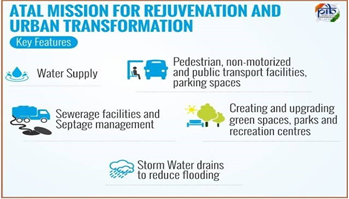
What is the Atal Mission for Rejuvenation and Urban Transformation (AMRUT)?
- About
- AMRUT was launched in 2015 to provide basic civic amenities like water supply, sewerage, urban transport, and parks to improve the quality of life for all, especially the poor and the disadvantaged.
- The focus of the Mission is on infrastructure creation that has a direct link to the provision of better services to the citizens.
- Objective
- Ensure that every household has access to a tap with an assured supply of water and a sewerage connection.
- Increase the amenity value of cities by developing greenery and well-maintained open spaces, e.g., parks.
- Reduce pollution by switching to public transport or constructing facilities for non-motorized transport, e.g., walking and cycling.
- Coverage
- The Mission covers 500 cities, including all cities and towns with a population of over one lakh with notified Municipalities.
- Achievements
- AMRUT has been ensuring water security by adding 1.1 crore household water tap connections and 85 lakh sewer connections, benefiting more than 4 crore people.
What is the AMRUT 2.0?
- About
- AMRUT 2.0 was launched on 01 October 2021, for a period of five years, from the financial year 2021-22 to the financial year 2025-26.
- The scheme is designed to ensure universal coverage of water supply through functional taps to all households in all statutory towns across the country.
- Aim
- Providing 100% coverage of water supply to all households in around 4,800 urban local bodies by providing about 2.68 crore tap connections.
- Achieving 100% coverage of sewerage and septage in 500 AMRUT cities by providing around 2.64 crore sewer or septage connections.
- Principles and Mechanism
- AMRUT 2.0 will adopt the principles of a circular economy and promote conservation and rejuvenation of surface and groundwater bodies.
- The Mission will promote data-led governance in water management and establish a Technology Sub-Mission to leverage the latest global technologies and skills.
- ‘Pey Jal Survekshan’ will be conducted to promote progressive competition among cities.
- Coverage
- AMRUT 2.0 will extend coverage from 500 cities under the first phase to 4,800 cities and towns.
- It will provide water tap connections to 26.8 million urban households.
- It will benefit more than 10.5 crore people in urban areas.
- The approved plan size for the UT of Puducherry under the AMRUT scheme is ₹64.91 crore for the entire Mission period, which is fully funded through the Central share.
- So far, ₹44.09 crore has been released for project implementation, against which Utilisation Certificates (UCs) amounting to ₹32.68 crore have been received.
- Funding
- AMRUT 2.0 was approved with Central assistance of Rs 66,750 crore from 2021-2022 until 2025-2026, with the total estimated outlay at Rs 2.99 lakh crore.
- The UT of Puducherry has taken up 24 projects worth ₹60.52 crore under AMRUT.
- Of these, 15 projects worth ₹19.41 crore have been completed.
- Six projects worth ₹25.03 crore are currently under implementation.
- Three projects worth ₹16.08 crore are under the tendering process.
- To date, works worth ₹36.65 crore have been physically completed.
What are the AMRUT 2.0 and Govt’s 100-day Plan?
- Govt’s Plan
- Under AMRUT 2.0, cities will launch projects worth Rs 5,000 crore focusing on water supply, sewage treatment, and rejuvenation of water bodies and parks.
- Current Status
- In a reply to the Lok Sabha on July 25 this year, the Ministry of Housing and Urban Affairs (MoHUA) stated that:
- 4,065 projects worth Rs 77,317.40 crore out of the total 8,205 projects worth Rs 1.82 lakh crore had been awarded.
- The total indicative outlay for AMRUT 2.0 is ₹2,99,000 crore, which includes a Central outlay of ₹76,760 crore for five years.
- This outlay includes funding of ₹22,000 crore (₹10,000 crore as Central Assistance) for ongoing projects of AMRUT until March 2023.
- 4,410 projects worth Rs 1.05 lakh crore were in the stage of floating tender or preparation of detailed project reports (DPR).
- Around 50 percent of the approved projects relate to the management of water supply, sewerage, and septage.
- Projects covering rejuvenation of water bodies, development of parks, groundwater recharge, and urban flood mitigation are also being implemented under AMRUT 2.0.
- In a reply to the Lok Sabha on July 25 this year, the Ministry of Housing and Urban Affairs (MoHUA) stated that:
- 100-Day Agenda:
- Under the 100-day agenda, cities aim to commission 500 MLD of sewage treatment plants and 150 MLD of water treatment plants, benefiting 8 lakh households.
- The government's broader 100-day agenda includes the Delhi Master Plan 2041 and the creation of eight greenfield cities, each with Rs 1,000 crore funding as recommended by the 15th Finance Commission.
|
UPSC Civil Services Examination, Previous Year Question (PYQ) Prelims: Q:1 With reference to Ayushman Bharat Digital Mission, consider the following statements: (2022)
Which of the statements given above is/are correct?
Ans: (d)
Q:2 Consider the following statements: (2011) In India, a Metropolitan Planning Committee
Which of the statements given above is/are correct?
Ans: (a) Mains Q:1 With a brief background of quality of urban life in India, introduce the objectives and strategy of the ‘Smart City Programme.’ (2016) |
Source: IE
Substantive Equality of Opportunity
Why in the news?
- The Supreme Court has allowed states to sub-classify Scheduled Castes (SCs) and Scheduled Tribes (STs) for reservations in jobs and education, promoting "substantive equality of opportunity" for backward classes.
- This ruling overrules the 2005 E.V. Chinnaiah case decision that prohibited such sub-categorization.
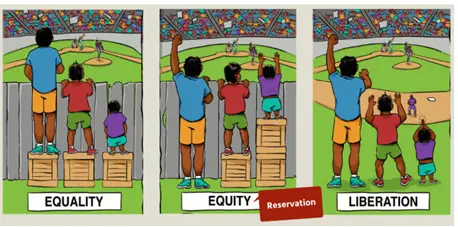
What is Substantive Equality of Opportunity?
- Concept of Substantive Equality:
- Beyond Formal Equality: Recognizes that treating everyone the same does not necessarily result in true equality due to historical disadvantages and social inequalities.
- Articles 16(1) and 16(2): Ensure formal equality and prohibit discrimination.
- Substantive Equality: Achieved through:
- Article 16(4): Allows reservations for backward classes in state services.
- Article 16(4A): Permits reservations in promotions for SCs and STs.
- Article 16(4B): Deals with carrying forward unfilled reserved vacancies.
- Exceptions: For certain positions requiring specific qualifications.
- CJI DY Chandrachud’s Views on Substantive Equality of Opportunity:
- Principle of Substantive Equality: Focuses on addressing social backwardness and historical disadvantages, aiming for true equality rather than mere formal equality.
- Interpretation of Articles 16(4) and 15(4):
- Encompasses socially and educationally backward classes.
- Affirms the state's authority to sub-classify within backward classes based on inadequate representation.
- Requires the state to demonstrate that inadequacy in representation is linked to backwardness.
- Emphasises a refined approach to affirmative action, addressing specific disadvantages within sub-groups.
- Dynamic Interpretation: Supports a flexible and evidence-based system for reservation policies, reflecting the evolving nature of social inequality.
Procedures for Substantive Equality of Opportunity as per CJI DY Chandrachud:
- Data Collection: Comprehensive data on representation of SCs and STs in public services to inform policy.
- Article 16(1): Promotes both formal and substantive equality in public employment.
- Article 16(4): Empowers the state to make special provisions for SCs and STs.
- Article 335: Reinforces the need to consider SC and ST claims in public services.
- Administrative Efficiency: Conceptualized to promote inclusivity and equality, aligned with Article 16(1).
- Affirmative Action Policies: Design and implement policies based on collected data and constitutional interpretation.
- Periodic Reviews: Evaluate effectiveness of measures and adjust as needed.
- Mechanism for Complaints: Address discrimination or inadequate implementation.
- Outreach Programs: Inform SC and ST communities about opportunities and ensure transparency.
- Training and Support: Enhance competitiveness of SC and ST candidates in public service examinations.
Historical Context of SC's Interpretations on Affirmative Action:
- State of Madras v. Champakam Dorairajan (1951): Initially viewed reservations as an exception to equal opportunity.
- First Constitutional Amendment (1951): Inserted Article 15(4) allowing reservations in education.
- M R Balaji v. State of Mysore (1962): Prescribed a 50% ceiling for reservations.
- State of Kerala v. N M Thomas (1975): Expanded interpretation to relax qualifying criteria for SC/ST candidates.
- Indra Sawhney v. Union of India (1992): Held that reservations are exceptions to equality, and reservations in promotions could dilute efficiency.
- Constitution (Seventy-seventh) Amendment Act, 1995: Allowed reservations in promotions and addressed consequential seniority.
- Chinnaiah Judgment (2005): The 2005 judgement ruled that SCs are a homogeneous group, and sub-classification would violate the doctrine of reasonableness and Article 14 (right to equality).
Recent State of Punjab v. Davinder Singh Case (2024):
- Emphasis on Substantive Equality:
- Chief Justice of India’s Stance: The ruling highlights the need for substantive equality, accounting for historical injustices and varying backgrounds.
- Sub-Categorisation of SCs/STs: Declared as a constitutional necessity to ensure that the benefits of reservations are more effectively distributed within these groups.
- Revised View on Quota vs. Efficiency:
- Higher examination scores are not necessarily linked to greater efficiency, and the stereotype of inefficiency often hinders the career progress of SC/ST candidates.
Conclusion:
The Supreme Court’s recent ruling supports a more nuanced approach to reservations by allowing states to sub-classify SCs and STs. This decision aims to achieve substantive equality by recognizing the diverse needs within these groups and ensuring that benefits are distributed more equitably.
Source: IE
Scientists make of the R&D Budget in Modi’s third term
Why in the news?
- Research and Development (R&D) involves activities aimed at creating new products or services and enhancing existing ones.
- It includes promoting innovation through incubators, scaling innovations, and fostering an innovation-friendly environment.
Investment in R&D:
- In 2020-21, India's total R&D investment was $17.2 billion. Of this, 54% ($9.4 billion) was allocated to the government sector.
- Key government agencies receiving R&D funds:
- Defence Research and Development Organisation (30.7%)
- Department of Space (18.4%)
- Indian Council of Agricultural Research (12.4%)
- Department of Atomic Energy (11.4%)
- Government funding is critical, driving strategic research and technological development through autonomous laboratories.
Public vs Private Contribution:
- Indian private industry contributes approximately $6.2 billion (37%) of Gross Domestic Expenditure on R&D (GERD), compared to the global average where business enterprises contribute over 65%.
- Leading innovative economies (China, Japan, South Korea, U.S.) typically see over 70% of R&D funding from private industries, reflecting market-driven forces and profit motives.
Comparing India’s R&D Funding:
- Growth: India's GERD grew from ₹6,01,968 million in 2010-11 to ₹12,73,810 million in 2020-21.
- Percentage of GDP: R&D investment as a percentage of GDP stands at 0.64%, below major developed and emerging economies like:
- China (2.4%)
- Germany (3.1%)
- South Korea (4.8%)
- United States (3.5%)
- Academic Output:
- PhDs: India generates 40,813 annually, ranking third globally.
- Publications: India had over 300,000 publications in 2022, ranking third worldwide.
- Patents: India ranks sixth with 30,490 patents in 2022.
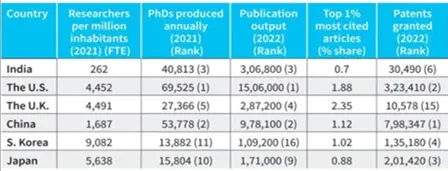
Budget 2024-25 and R&D: Leading Scientists’ Opinions:
- N. Kalaiselvi, Director-General, CSIR:
- Focus Areas: Climate-resilient agriculture, critical minerals, miniature nuclear technology, energy-efficient technologies.
- Budget Priority: Emphasises basic research, prototype development, and industry linkages.
- Sectoral Boosts: Significant focus on the space sector, agriculture productivity, energy security, and manufacturing.
- Critical Minerals: Customs duty exemption on 25 critical minerals.
- Clean Energy and Waste Management: Prioritised with involvement in technology development.
- Funding: Rs 6,323 crore allocated for the Department of Scientific and Industrial Research.
- Rajesh Gokhale, Secretary, DBT:
- Agriculture Research: Focus on productivity and climate resilience.
- Speed Breeding Platforms: Shorten crop development cycles.
- Biotechnology Innovation: New PhD programs and angel tax abolition to support startups.
- Subhash Lakhotia, Distinguished Professor, Banaras Hindu University:
- Budget Allocation: Similar to 2022-2023, with less than 10% increase, affected by inflation.
- Funding Concerns: Increased competition and reduced per capita funding.
- Zero Budgeting System: Issues with mandated quarterly reports impacting research quality.
- Others:
- ANRF and Space Technology: Operationalization and venture capital fund for space startups.
- Clean Energy: Measures for solar and nuclear energy, reduced taxation on raw materials.
- Pharmaceutical Manufacturing: Increased allocation for PLI scheme.
- Space Technology Fund: Rs 1,000 crore venture capital fund for space technology.
- Nuclear Technology: Push for R&D in new nuclear technology and small reactors.
- ANRF Clarification: Focus on prototype development in basic research remains unclear.
- Funding Disparity: Need for mechanisms to address funding disparities between central and state-run institutions.
About Anusandhan National Research Foundation (ANRF):
- About:
- ANRF is a major initiative by the Government of India aimed at enhancing the research and innovation ecosystem in the country.
- It supports high-quality research across various disciplines and encourages private sector investment in research.
- Key Features:
- Support for Higher Education Institutions (HEIs): Provides support to state-run HEIs to address historical funding disparities.
- Innovation and Industry Linkages: Promotes collaboration between research institutions and industries to commercialise research and foster innovation.
- Strategic Research Areas: Focuses on national importance areas such as clean energy, critical minerals, climate resilience, and advanced technologies.
- Operational Framework: Provides grants and funding for research projects, especially in strategic and high-impact areas.
- Corpus Fund: Rs 1 lakh crore allocated to ensure sustained funding for research activities.
Conclusion
India's R&D landscape, including investment details, public vs private contributions, and comparisons with global standards. It also provides insights into the recent budget allocations and the objectives of the Anusandhan National Research Foundation in shaping the future of research and innovation in India.
Source: TH
Bent-Toed Geckos
Why in the news?
- Recently, scientists from India and the United Kingdom have described six new species of bent-toed geckos from Northeast India.
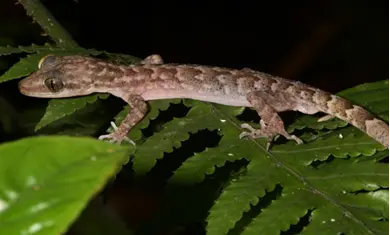
About Bent-Toed Geckos:
- Genus Cyrtodactylus: Bent-toed geckos belong to the genus Cyrtodactylus.
- Common Names: These geckos are commonly known as bow-fingered geckos and forest geckos.
- Ectothermic Nature: Geckos are ectothermic, meaning they rely on external sources of heat to regulate their body temperature.
- Reproduction: Reproduction in bent-toed geckos typically occurs during the warm and wet seasons.
- Distribution: Bent-toed geckos have about 346 species distributed across multiple biogeographic zones, including Peninsular India, Sri Lanka, the Himalayan foothills, Northeast India, Southeast Asia, and the Solomon Islands.
Highlights about the New Species:
- Namdapha Bent-Toed Gecko:
- Location: Documented from the Namdapha Tiger Reserve in Arunachal Pradesh.
- Habitat: Widespread within the lowland evergreen forests of the Namdapha and Kamlang Tiger Reserves.
- Siang Valley Bent-Toed Gecko:
- Location: Discovered in the Siang River valley, Arunachal Pradesh.
- Significance: Renowned for its unique biodiversity.
- Ngengpui Bent-Toed Gecko:
- Location: Discovered in the Ngengpui Wildlife Sanctuary of Lawngtlai district, Mizoram.
- Significance: The site is located in one of the easternmost protected areas of the country.
- Manipur Bent-Toed Gecko:
- Location: Discovered near the Lamdan Kabui village, Manipur.
- Kiphire Bent-Toed Gecko:
- Location: Discovered in Nagaland.
- Barail Hill Bent-Toed Gecko:
- Location: Discovered in Nagaland.
Conclusion:
These discoveries contribute significantly to our understanding of the biodiversity in Northeast India and emphasise the region's importance as a hotspot for herpetofaunal diversity.
Source: DTE
Pobitora Wildlife Sanctuary
Why in the news?
- Recently, a mahout from Darrang district met a grisly end at the Pobitora Wildlife Sanctuary after a wild elephant trampled him to death.
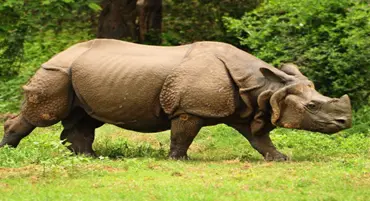
About Pobitora Wildlife Sanctuary:
- Location:
- Situated on the southern bank of the river Brahmaputra in Morigaon district, adjacent to Guwahati, Assam.
- Declared a reserve forest in 1971 and a wildlife sanctuary in 1987.
- Significance:
- Home to the highest population density of the Indian One-Horned Rhinoceros species, with around 102 rhinos in an area of 38.8 sq. km.
- Landscape:
- Dominated by alluvial lowlands and marshland.
- The Brahmaputra River forms a natural boundary to the north, while the Garanga Beel forms a natural boundary to the south.
- Flora:
- 72% of Pobitora consists of wet savannah, including species such as Arundo donax, Erianthus ravennae, Phragmites karka, Imperata cylindrica, and Saccharum spp.
- Water hyacinth (Eichornia crassipes) is a significant problem, especially for waterfowl, as it forms thick mats on the water surface.
- Fauna:
- Besides rhinoceros, the sanctuary is home to leopards, wild boar, barking deer, wild buffalo, and more.
- It also hosts more than 375 species of resident and migratory birds, including the Indian pied Hornbill, Osprey, Hill Myna, and Kalij Pheasant.
Conclusion:
Pobitora Wildlife Sanctuary is a crucial habitat for the conservation of the Indian One-Horned Rhinoceros and plays a significant role in preserving the biodiversity of the region.
Source: IT
Astra Missile
Why in the news?
- The Indian Air Force (IAF) has given clearance to the Defence Research and Development Organisation (DRDO) and Bharat Dynamics Limited (BDL) to produce 200 Astra air-to-air missiles for its Su-30 and LCA Tejas fighter aircraft.

About Astra Missile:
- Type: Beyond-Visual-Range (BVR) air-to-air missile
- Developed by: Defence Research and Development Organisation (DRDO)
- Manufactured by: Bharat Dynamics Ltd. (BDL)
- Purpose: To engage and destroy highly manoeuvrable, supersonic aerial targets
- Usage: Mounted on fighter aircraft such as Su-30 and LCA Tejas
Features of Astra Mk-I:
- Dimensions:
- Length: 3.6 meters
- Diameter: 178 mm
- Weight: 154 kg
- Range: 80 to 110 km in a head-on chase
- Speed: 5 Mach (almost hypersonic)
- Guidance System:
- Inertial guidance driven by a fibre optic gyroscope
- Terminal guidance through active radar homing
- Operational Modes:
- Lock on Before Launch (LOBL)
- Lock on After Launch (LOAL)
- Engine Technology: Advanced solid-fuel ducted ramjet (SFDR)
- Capabilities:
- Advanced air combat engagement
- High overall reliability
- Very high Single Shot Kill Probability (SSKP)
- Capable of operating under all weather conditions, both day and night
Significance:
- Astra is the best in its class of air-to-air missiles globally.
- It enhances the IAF's combat capabilities by allowing engagements with multiple high-performance targets.
- The development of multiple variants ensures the missile meets specific operational requirements.
Conclusion
By integrating the Astra missile into its fleet, the Indian Air Force aims to significantly boost its aerial combat capabilities, ensuring enhanced national security and operational readiness.
Source: NDTV
WHO Global Traditional Medicine Centre (WHO GCTM)
Why in the news?
- Recently, India has pledged $85 million over the period of 2022–2032 to support the programming of the WHO Global Traditional Medicine Centre (WHO GCTM).
- This commitment is part of a broader $250 million investment from India towards establishing and supporting the WHO GCTM.
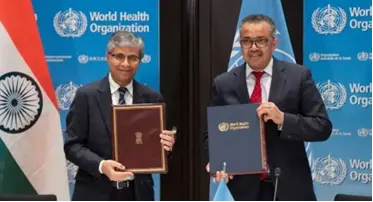
About WHO Global Traditional Medicine Centre (WHO GCTM):
- Location: Jamnagar, Gujarat, India
- Establishment:
- Laid the foundation stone in April 2022 by the Indian Prime Minister, with the presence of the WHO Director-General.
- It is the first global centre dedicated to traditional medicine.
- Objective:
- To leverage traditional medicine through modern science and technology.
- To improve global health and integrate traditional medicine into health systems.
- To build a robust evidence base for policies and standards regarding traditional medicine practices and products.
- To regulate quality and safety for optimal and sustainable impact.
- Strategic Areas of Focus:
- Evidence and Learning: Building and validating evidence on traditional medicine practices.
- Data and Analytics: Utilising data to guide policies and practices.
- Sustainability and Equity: Ensuring that traditional medicine practices contribute to sustainable and equitable health solutions.
- Innovation and Technology: Using advanced technology to enhance the role of traditional medicine in global health.
- Guiding Principles:
- Respect for local heritages, resources, and rights.
Conclusion
The WHO GCTM aims to enhance the global understanding and application of traditional medicine, ensuring it is effectively integrated into health systems worldwide while respecting traditional knowledge and practices.
Source: TH
India-Bangladesh Relations under Sheikh Hasina: A 50-Year
Context:
- India's relationship with Bangladesh faces uncertainty following the resignation of Prime Minister Sheikh Hasina amid violent protests.
- The Army has announced an interim government to oversee the transition.
- After leaving Dhaka, she arrived at Hindon Air Base in Uttar Pradesh's Ghaziabad.
- She held talks with National Security Advisor Ajit Doval on the present situation in Bangladesh and her future course of action.
- The Indian Air Force and other security agencies are providing security to Hasina.
- While speculation exists, that Hasina might travel to London, reports also suggest she could head to Belarus.
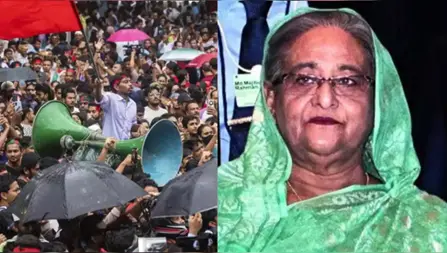
Brief Political History of Bangladesh:
- Formation and Early Years (1971-1975):
- 1971: Bangladesh gained independence, with Sheikh Mujibur Rahman of the Awami League becoming the first Prime Minister.
- 1975: Rahman was assassinated in a coup.
- Military Rule and Political Instability (1975-1990):
- 1975: Chief Justice Abu Sadat Mohammad Sayem appointed as president; military junta established.
- 1977: Gen Ziaur Rahman became president but was assassinated in 1981.
- 1982: Abdus Sattar ousted by a coup led by Army Chief H M Ershad, who resigned in 1990 due to widespread unrest.
- Civilian Governments and Attempts at Stability:
- 1991-96 and 2001-06: Terms served by Khaleda Zia and Sheikh Hasina, with an attempted coup in 1996.
- 2006-2008: Military-influenced caretaker government during a period of unrest.
- Post-2008 Stability:
- 2008: Sheikh Hasina returned to power, ensuring the military returned to barracks.
- 2010: The Supreme Court limited military interventions and reinforced secularism in the constitution.
India – Bangladesh Bilateral Relationship:
- Historical Ties:
- 1971: India played a key role in Bangladesh's independence from Pakistan.
- Mid-1970s: Relations strained due to boundary disputes and water-sharing issues, exacerbated by subsequent military regimes in Bangladesh.
- 1996: Stability restored under Sheikh Hasina’s leadership, including the Ganga Water Sharing Treaty.
- Economic Cooperation:
- Trade Growth:
- Recent Trends: Bangladesh is India's 25th largest trading partner, with bilateral trade totaling $12.9 billion.
- India’s exports to Bangladesh contracted by 9.5% to $11 billion in FY24.
- Comprehensive Economic Partnership Agreement (CEPA):
- Feasibility Study: In 2022, India and Bangladesh concluded a joint feasibility study on a CEPA.
- Significance: The CEPA is crucial as Bangladesh will lose its Least Developed Country (LDC) status after 2026, affecting its duty-free and quota-free access to Indian markets.
- Free Trade Agreement (FTA):
- Negotiations: Bangladesh aims to finalise an FTA with India and is also pursuing the China-backed Regional Comprehensive Economic Partnership (RCEP), which raises concerns for India.
- Trade Growth:
- Infrastructure:
- Lines of Credit:
- Support: Since 2010, India has extended over USD 7 billion in Lines of Credit to Bangladesh for infrastructure development.
- Key Projects:
- Land Boundary Agreement (LBA): Resolved in 2015, addressing long-standing boundary disputes.
- Akhaura-Agartala Rail Link: Inaugurated in 2023, linking Bangladesh with India’s northeast through Tripura and improving access to Chattogram and Mongla ports.
- BIMSTEC Master Plan:
- Connectivity: Focuses on integrating major transport projects in India, Bangladesh, Myanmar, and Thailand, and establishing a shipping network.
- Matarbari Port: India will emphasise this port, which is being built by Bangladesh, to create a vital industrial corridor connecting Dhaka and Northeast India.
- Lines of Credit:
- Energy:
- Volume: Bangladesh imports nearly 2,000 MW of electricity from India.
- Rooppur Nuclear Power Plant: Signed a memorandum in 2018 involving Russia, Bangladesh, and India, marking Bangladesh’s entry into nuclear energy with its first reactor.
- Thermal Power Plant Project: Key initiatives include the Maitree Super Thermal Power Plant and the India-Bangladesh Friendship Pipeline.
- Defence Cooperation:
- Border Management:
- Extent: India and Bangladesh share a 4096.7 km border, the longest land boundary India shares with any neighbour.
- Joint Exercises:
- Army: Exercise Sampriti.
- Navy: Exercise Bongo Sagar.
- Border Management:
- Multilateral Cooperation:
- Regional Forums:
- SAARC: South Asian Association for Regional Cooperation.
- BIMSTEC: Bay of Bengal Multi-Sectoral Technical and Economic Cooperation.
- IORA: Indian Ocean Rim Association.
- Regional Forums:
Impact of Sheikh Hasina's Exit on India:
- Loss of a Trusted Partner:
- Historical Ties: Sheikh Hasina's resignation ends a 17-year period of strong bilateral relations with India, marked by significant cooperation on counterterrorism and security concerns.
- Strategic Challenges:
- Chinese Influence: Increased Chinese presence in Bangladesh threatens India's strategic interests, risking encirclement by unfriendly neighbours, including China and Pakistan.
- Strategic Projects: Projects like the Teesta Reservoir are under Chinese scrutiny, highlighting India's concerns over regional influence.
- BNP Rule Legacy:
- Anti-India Sentiment: BNP's previous rule saw heightened anti-India rhetoric and support for insurgents. The new government’s stance on India remains uncertain.
- Border Security:
- Regional Instability: Tensions at the LoC and eastern Ladakh, along with a volatile Myanmar border, make stability in Bangladesh crucial for India’s security.
- Islamist Extremism:
- Potential Risks: Hasina's exit might lead to a resurgence of radical extremism in Bangladesh, which could pose new security threats for India.
- Diplomatic Approach:
- Current Stance:
- India has treated the protests in Bangladesh as an internal issue while supporting Hasina.
- Future diplomacy will need to adjust to the new Bangladeshi government, managing relations and ensuring continued cooperation.
- Current Stance:
Conclusion:
India must navigate the evolving political landscape in Bangladesh carefully, balancing security, economic, and diplomatic interests amidst the uncertainty following Sheikh Hasina's resignation
|
UPSC Civil Services Examination, Previous Year Question (PYQ) Prelims Q:1 With reference to river Teesta, consider the following statements: (2017)
Which of the statements given above is/are correct?
Ans: (b)
Mains Q:1 Analyze internal security threats and transborder crimes along Myanmar, Bangladesh and Pakistan borders including Line of Control (LoC). Also discuss the role played by various security forces in this regard. (2018) |
Source: IE
Share the article
Edukemy’s Current Affairs Quiz is published with multiple choice questions for UPSC exams
MCQ
Get Latest Updates on Offers, Event dates, and free Mentorship sessions.

Get in touch with our Expert Academic Counsellors 👋
FAQs
UPSC Daily Current Affairs focuses on learning current events on a daily basis. An aspirant needs to study regular and updated information about current events, news, and relevant topics that are important for UPSC aspirants. It covers national and international affairs, government policies, socio-economic issues, science and technology advancements, and more.
UPSC Daily Current Affairs provides aspirants with a concise and comprehensive overview of the latest happenings and developments across various fields. It helps aspirants stay updated with current affairs and provides them with valuable insights and analysis, which are essential for answering questions in the UPSC examinations. It enhances their knowledge, analytical skills, and ability to connect current affairs with the UPSC syllabus.
UPSC Daily Current Affairs covers a wide range of topics, including politics, economics, science and technology, environment, social issues, governance, international relations, and more. It offers news summaries, in-depth analyses, editorials, opinion pieces, and relevant study materials. It also provides practice questions and quizzes to help aspirants test their understanding of current affairs.
Edukemy's UPSC Daily Current Affairs can be accessed through:
- UPSC Daily Current Affairs can be accessed through Current Affairs tab at the top of the Main Page of Edukemy.
- Edukemy Mobile app: The Daily Current Affairs can also be access through Edukemy Mobile App.
- Social media: Follow Edukemy’s official social media accounts or pages that provide UPSC Daily Current Affairs updates, including Facebook, Twitter, or Telegram channels.


